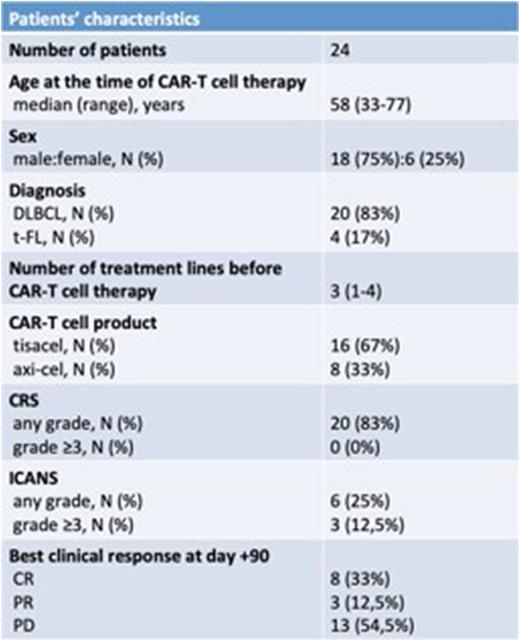Abstract
Introduction Chimeric antigen receptor (CAR)-T cell therapy is a promising immunotherapeutic strategy approved for the treatment of relapsed or refractory (r/r) B-cell lymphomas (e.g. diffuse large B cell lymphoma (DLBCL), mantel cell lymphoma (MCL), follicular lymphoma (FL)) after two or more treatment courses. In this setting CAR-T cell therapy can induce complete remission (CR) in a substantial proportion of patients (30-40%) with poor prognosis. Nevertheless, disease relapse still represents one of the major issues. Many efforts are being made to detect factors accounting for sustained remission after cell therapy. CAR-Ts expansion and persistence are thought to represent crucial factors influencing outcome. The identification of a reliable detection strategy of CAR-T cells is thus fundamental to assess/anticipate disease relapse and to tailor post CAR-T cell therapy strategy.
Materials and Methods In order to assess the presence of CAR-T cells in blood samples during follow-up of lymphoma patients undergoing CAR-T cell therapy with tisagenlecleucel (tisa-cel) or axicabtagene-ciloleucel (axi-cel), we developed a Taqman assay specific for the genomic sequence of the single-chain variable fragment (scFv), which encodes the antigen recognition site of the CAR construct of the two different CAR-T cell constructs. A semi-quantitative real-time PCR protocol was established in order to compare the amount of CAR-T DNA with reference genomic DNA sequences (KELL, IGF1, ASMA). The results were reported as CAR-T cell copies/1000 cells. CAR-T DNA was assessed from samples of peripheral blood at fixed time-points after infusion: day +7 and day +30 were the main reference points in order to detect/define expansion and persistence, respectively.
Results Between 05/2019 and 04/2022 24 patients with r/r DLBCL or transformed FL were treated with CAR-T cell therapy (tisa-cel, n=16, or axi-cel, n=8) at the University Hospital of Ulm. Patients' characteristics are listed in table 1. At three months after infusion, we documented an overall response rate of 46%, with a CR rate of 33%. With our PCR assay we detected the peak of expansion with a median of 56 CAR-T cells/1000 cells (range, 0-3215) and documented the persistence with a median of 59.5 CAR-T cells/1000 cells (range: 0-284). Comparing responders vs. non-responders, we noticed no significant differences in the median cell peak at the time of expansion (p=0.2), but a significant longer persistence in responders (99 vs. 23 CAR-T cells/1000 cells, responders vs. non-responders, p=0.00798). We also compared expansion and persistence according to the type of CAR-T cell product, knowing that axi-cel presents a greater expansion peak and that tisa-cel with the 4-1bb costimulatory domain is able to persist longer. We confirmed that axi-cel has a higher expansion as compared to tisa-cel (1251 vs. 49 CAR-T cells/1000 cells at day+ 7, respectively, p=0.003). There was no significant difference considering the persistence at day +30 between the two products (62 vs. 59,5 CAR-T cells/1000 cells, respectively for tisa-cel and axi-cel, p=0.432). Furthermore, in the tisa-cel subgroup CAR-T cell persistence at day +30 proved to be associated with clinical response in univariate analysis (99 vs. 21 CAR-T cells/1000 cells, respectively responders vs. non-responders, p=0.040), while expansion-peak did not seem to play a role in inducing response after treatment. In the axi-cel subgroup both the entity of CAR-T cell peak at day+ 7 (1959 vs. 1033 CAR-T cells/1000 cells for responders vs. non-responders, p= 0.40) and the persistence (125 vs. 23,5 CAR-T cells/1000 cells for responders vs. non-responders, p= 0.40) were significantly associated with clinical response 3 months after infusion.
Conclusions Reliable monitoring of CAR-T cell expansion and persistence may reveal patterns that correlate with clinical response to CAR-T treatment, thus representing a potential instrument able to give early information about the pharmacodynamic properties of CAR-Ts. This information could help to tailor the post-infusion strategy, also knowing that CAR-T cell persistence seems to exert a fundamental role in inducing continuous CR also across different CAR-T cell products. These results are retrospectively collected on a small and heterogeneous patient population and need to be validated in larger and prospective cohorts.
Disclosures
Döhner:Berlin-Chemie: Consultancy, Honoraria; Novartis: Consultancy, Honoraria, Research Funding; GEMoaB: Consultancy, Honoraria; Servier: Other: Travel, Accommodations, Expenses; Amgen: Consultancy, Honoraria, Research Funding; Celgene: Consultancy, Honoraria, Research Funding; Janssen: Consultancy, Honoraria; AstraZeneca: Consultancy, Honoraria; Syndax: Consultancy, Honoraria; AbbVie: Consultancy, Honoraria, Research Funding; Agios: Consultancy, Honoraria, Research Funding; Gilead: Consultancy, Honoraria; Astellas: Consultancy, Honoraria, Research Funding; BMS: Consultancy, Honoraria, Research Funding; Jazz Pharmaceuticals: Consultancy, Honoraria, Research Funding; Kronos Bio: Research Funding; Daiichi Sankyo: Membership on an entity's Board of Directors or advisory committees. Viardot:Kite Gilead: Consultancy, Honoraria, Other: Support for meeting attendance; Novartis: Consultancy, Honoraria, Other: Support for meeting attendance; BMS: Consultancy, Honoraria, Other: Support for meeting attendance; Roche: Consultancy, Honoraria, Membership on an entity's Board of Directors or advisory committees; Amgen: Consultancy, Honoraria, Other: Support for meeting attendance; Janssen-Cilag: Honoraria, Other: Support for meeting attendance; Astra Zeneca: Honoraria, Other: Support for meeting attendance; Incyte: Consultancy, Other: Support for meeting attendance. Sala:Novartis: Honoraria; Kite Gilead: Consultancy, Honoraria, Other: Travel Support; BMS: Consultancy, Honoraria; Jazz Pharmaceutical: Consultancy, Honoraria, Other: Travel Support; Takeda: Consultancy.
Author notes
Asterisk with author names denotes non-ASH members.


This feature is available to Subscribers Only
Sign In or Create an Account Close Modal